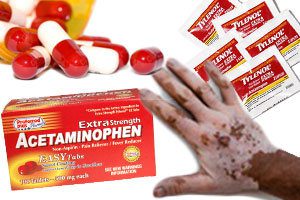
Acetaminophen May Cause Serious Skin Disorders. Federal regulators just issued a warning concerning acetaminophen’s (commonly found in Tylenol and other painkillers) ties to a rare, but potentially fatal skin disorder that is signaled, in early stages, with rash and blistering. The U.S. Food and Drug Administration (FDA) stated it has found evidence of an […]

Acetaminophen May Cause Serious Skin Disorders. Federal regulators just issued a warning concerning acetaminophen’s (commonly found in Tylenol and other painkillers) ties to a rare, but potentially fatal skin disorder that is signaled, in early stages, with rash and blistering. The U.S. Food and Drug Administration (FDA) stated it has found evidence of an association between acetaminophen use and Stevens-Johnson Syndrome (SJS), toxic epidermal necrolysis (TEN), and acute generalized exanthematous pustulosis (AGEP).
The FDA stated it now mandates all acetaminophen-containing prescription drugs to include a label warning concerning the diseases and seeks to add similar warnings to over-the-counter (OTC) medications containing acetaminophen. Patient advocates have long argued that drug allergy alert label information on many OTC drugs do not contain sufficient user warnings about the risk of SJS and TEN.
An FDA review of medical literature and its Adverse Event Reporting System (AERS) database prompted the warning. The review revealed more than 100 cases between 1969-2012 of SJS and TEN that ended in about one-dozen deaths. Most involved consumers ingesting products in which acetaminophen was the only ingredient.
The FDA previously indicated that more than 600 over-the-counter and prescription medicines contain acetaminophen, including Tylenol, which is manufactured and marketed by Johnson & Johnson. In fact, some drugs combine acetaminophen with other active ingredients for the treatment of pain and symptoms of colds, flu, allergy, and sleeplessness. To determine if an OTC drug contains acetaminophen, consumers should look for ”acetaminophen” on the Drug Facts label. If a prescription medicine contains acetaminophen, the label may not spell out the entire word or may contain the abbreviation “APAP.”
The most severe cases of SJS are referred to as TEN and occurs when over 30 percent of the body is impacted. Both SJS and TEN typically call for hospital burn unit treatment and the severe sensitivity reaction causes the following symptoms. AGEP is a severe, but less fatal form of the disorder:
The key to stopping SJS is early diagnosis and intervention, which includes stopping the medication that led to the condition. Warnings on many medications are vague and people tend to not realize that SJS has developed when they are experiencing the syndrome in initial stages. SJS and its symptoms are not widely known; therefore, people may ignore what, at first, appears to be a minor blister or rash, despite that these may signal the deadly disorders.
The personal injury attorneys at Parker Waichman LLP offer free, no-obligation case evaluations. For more information, fill out our online contact form or call 1-800-YOURLAWYER (1-800-968-7529).
Our Acetaminophen side effect lawyer is here to help you when you need it the most.


